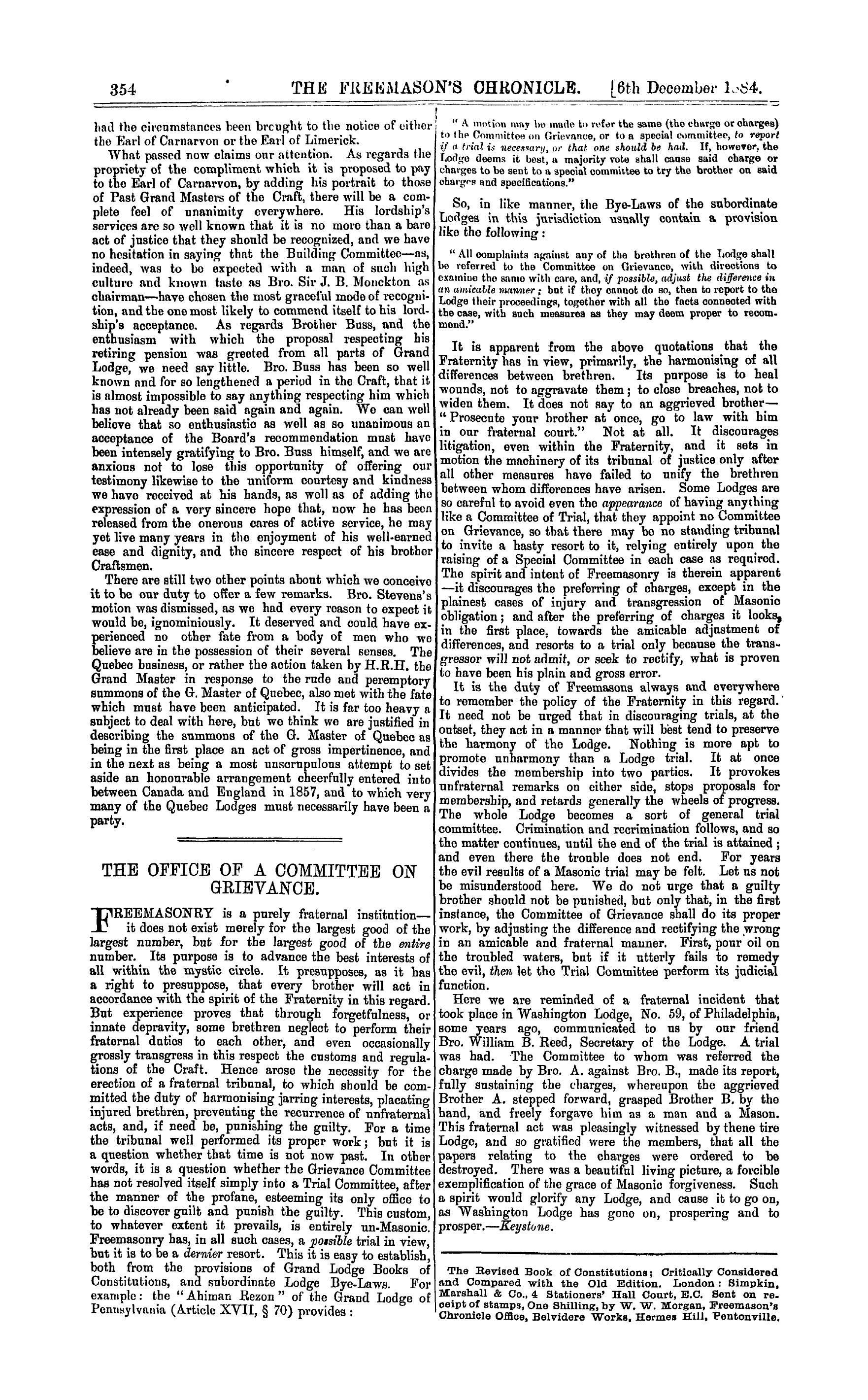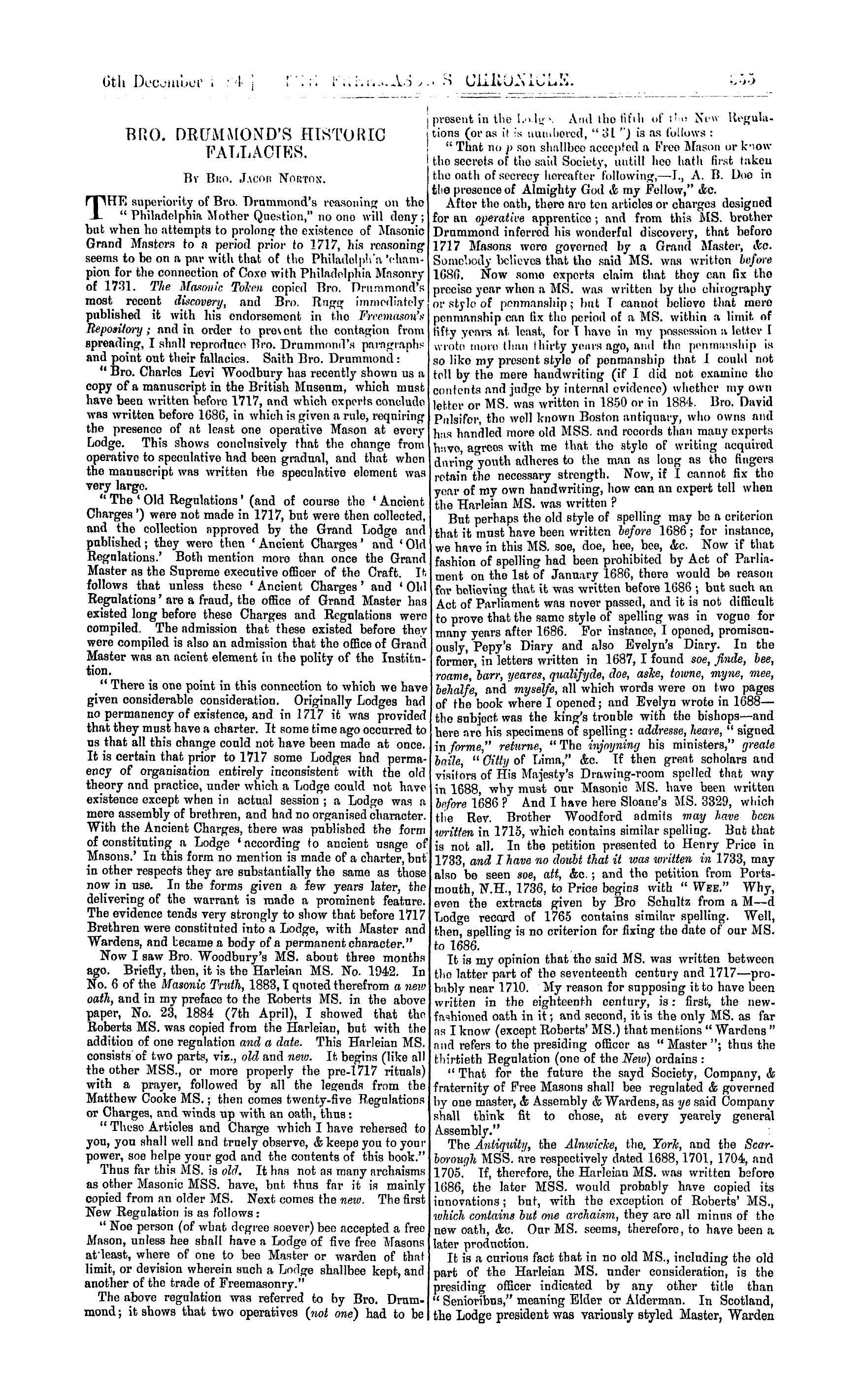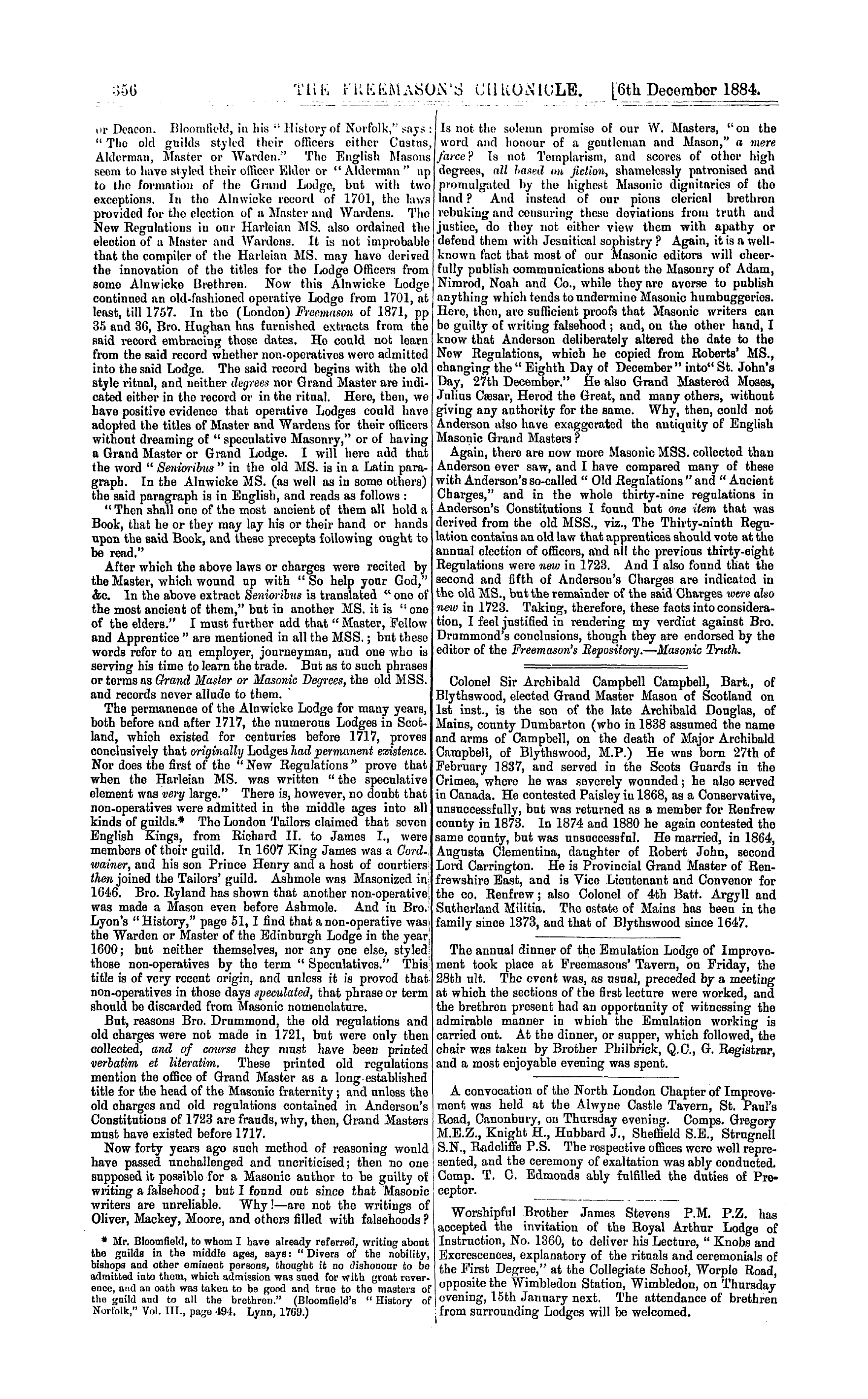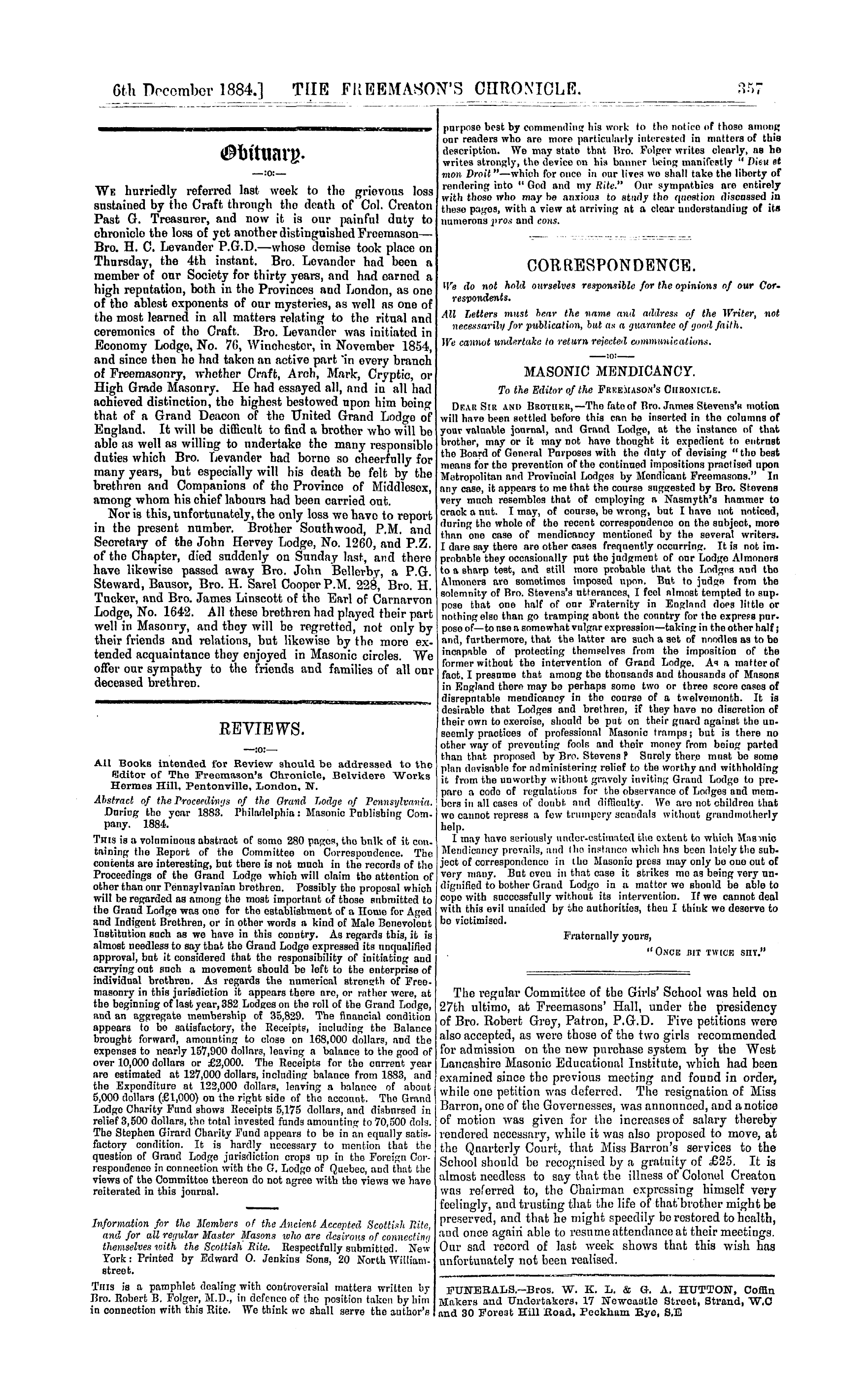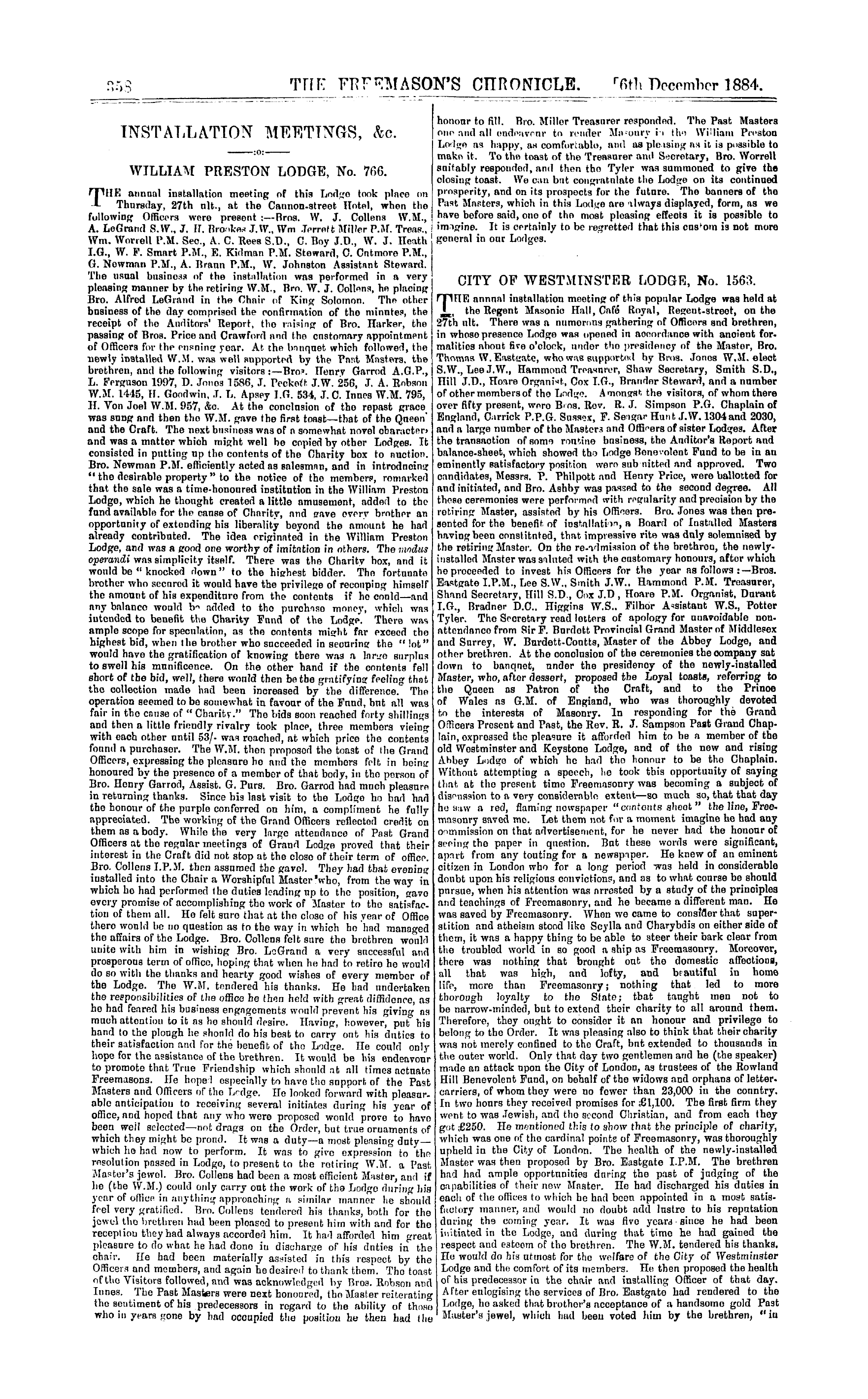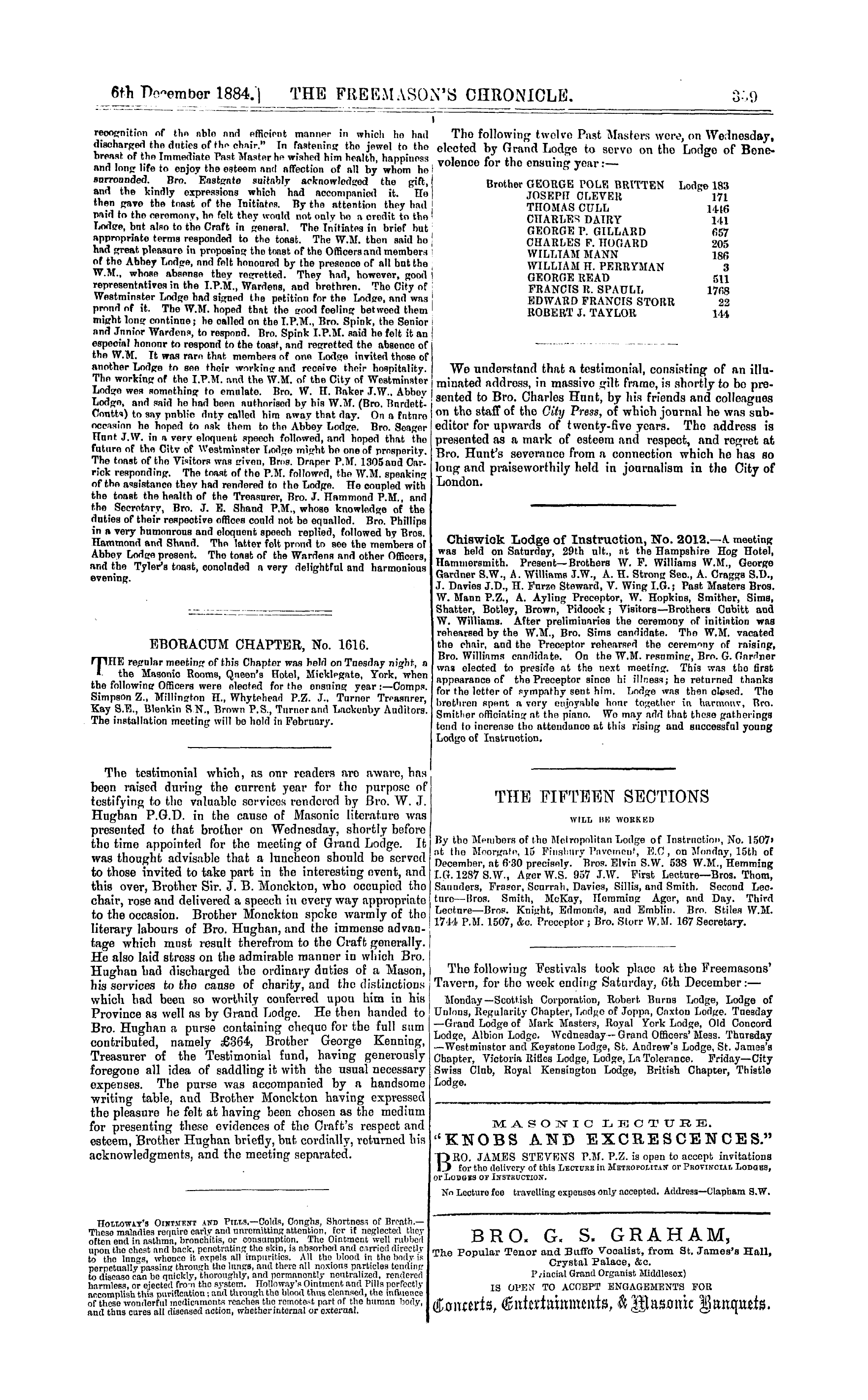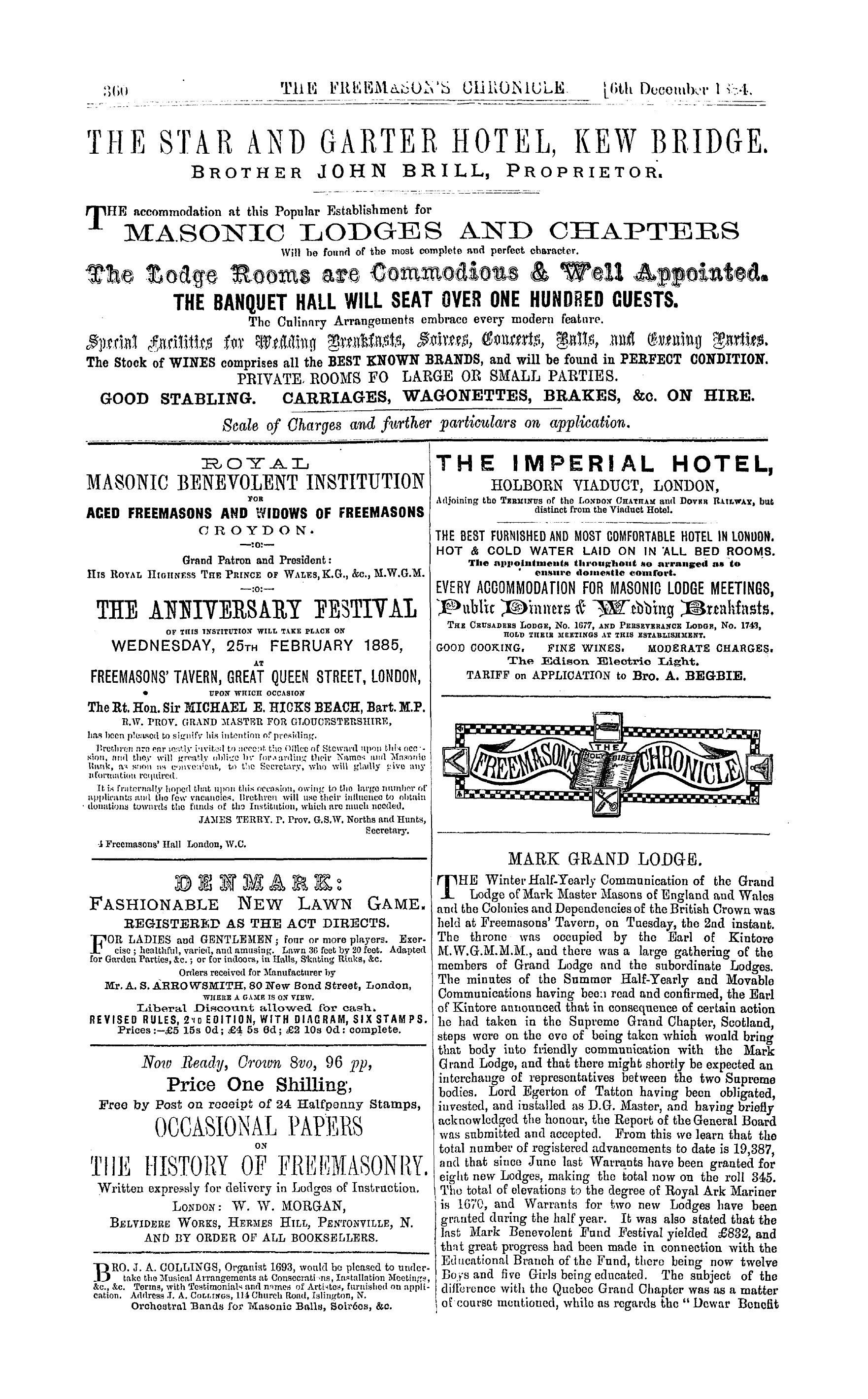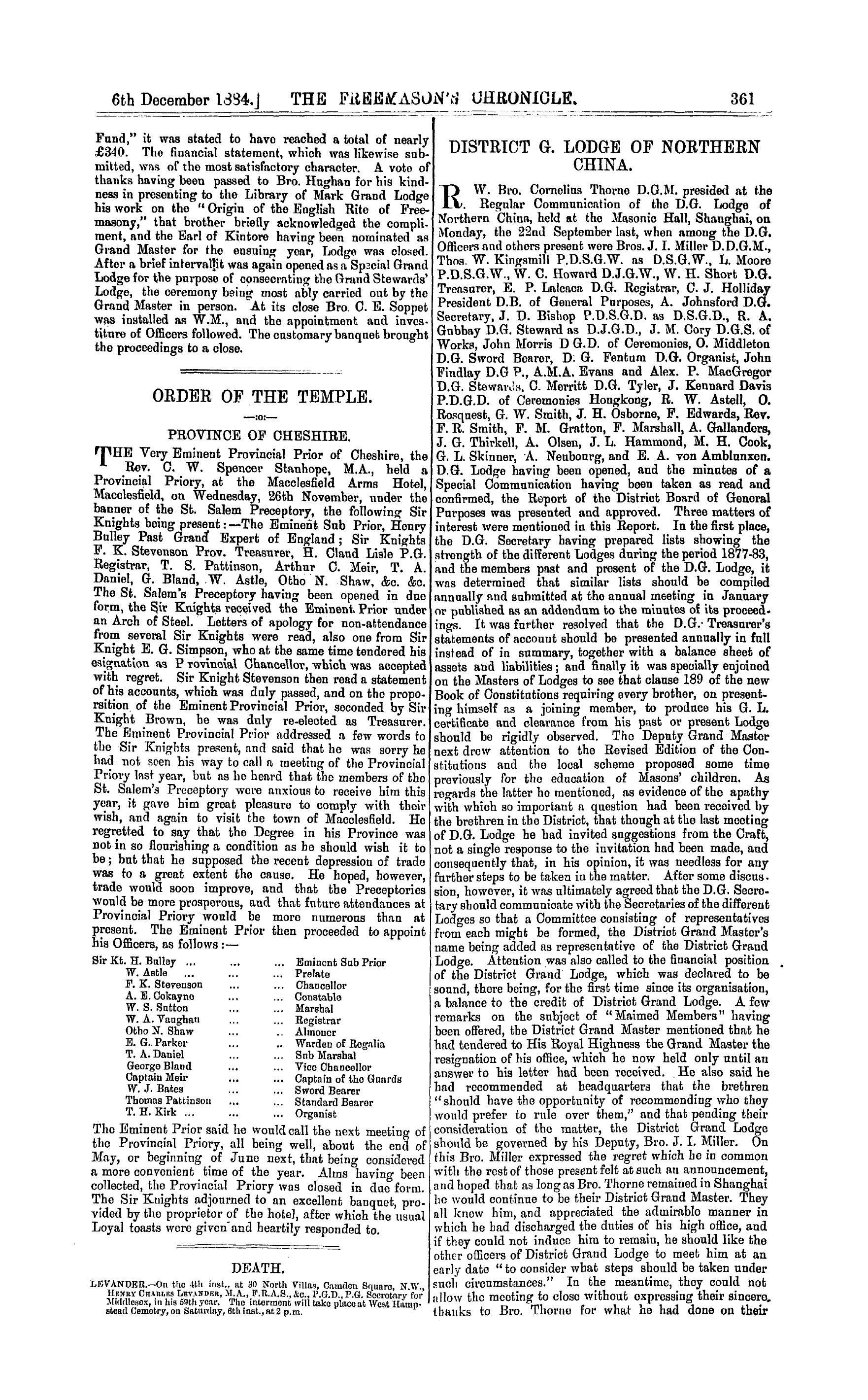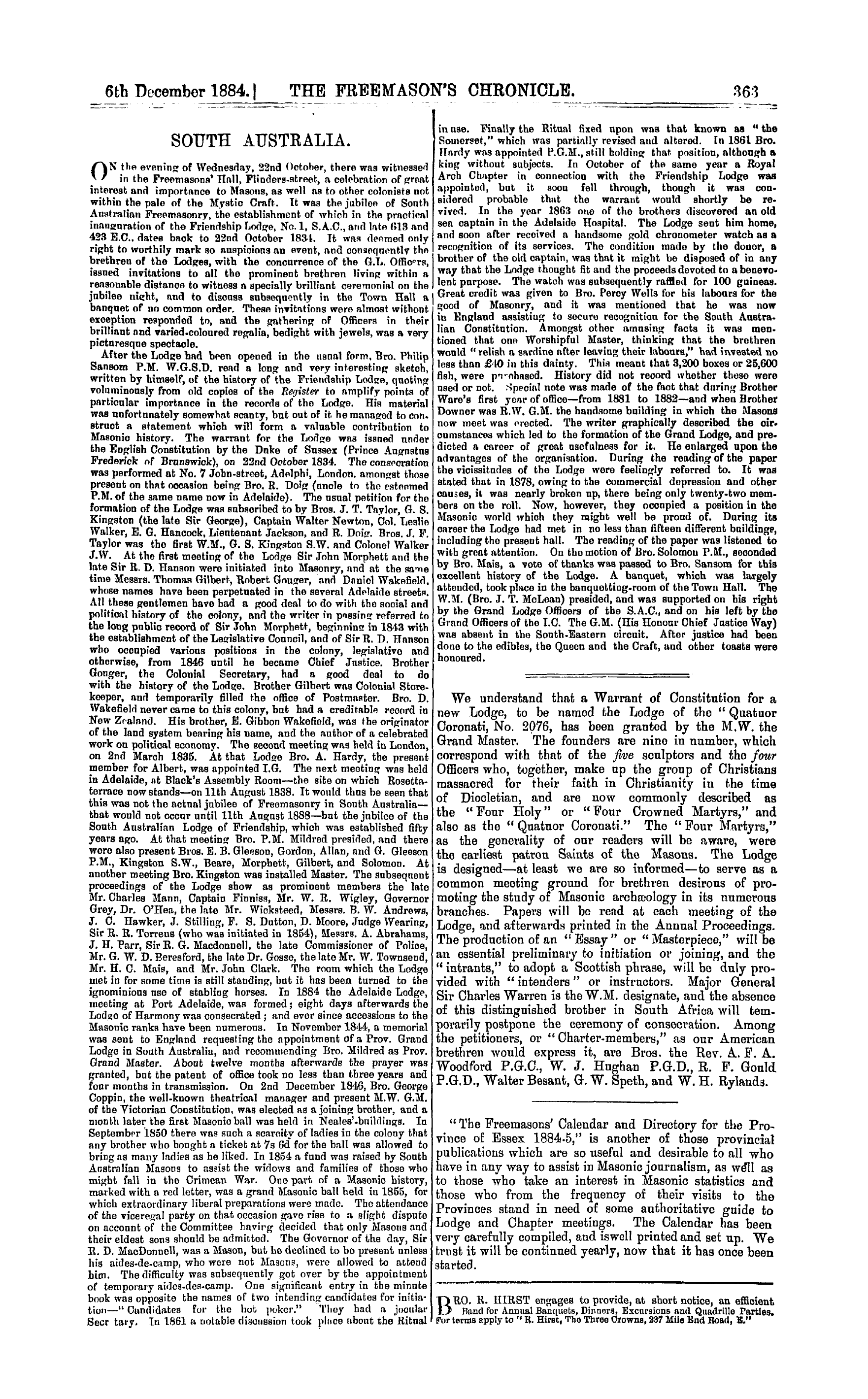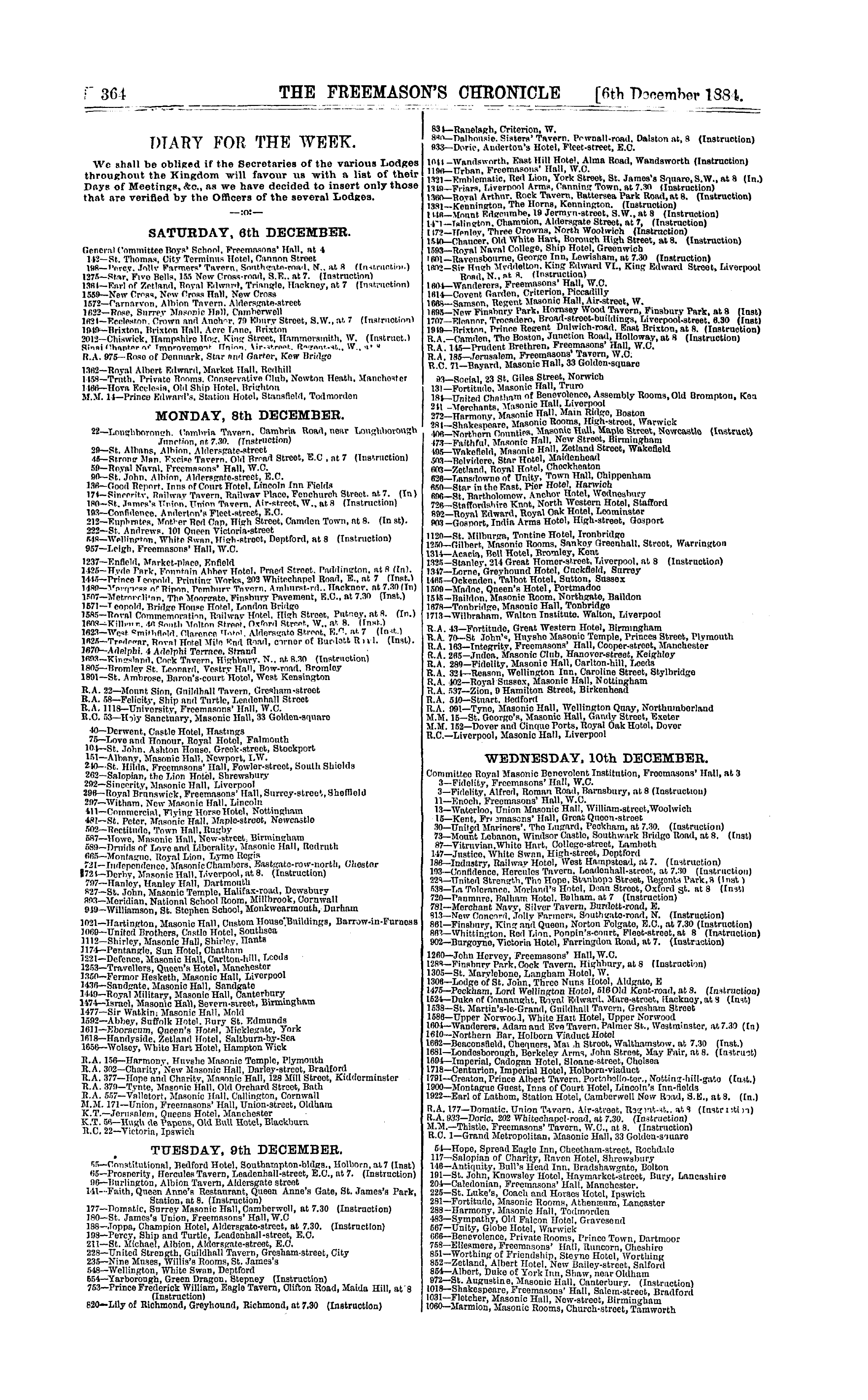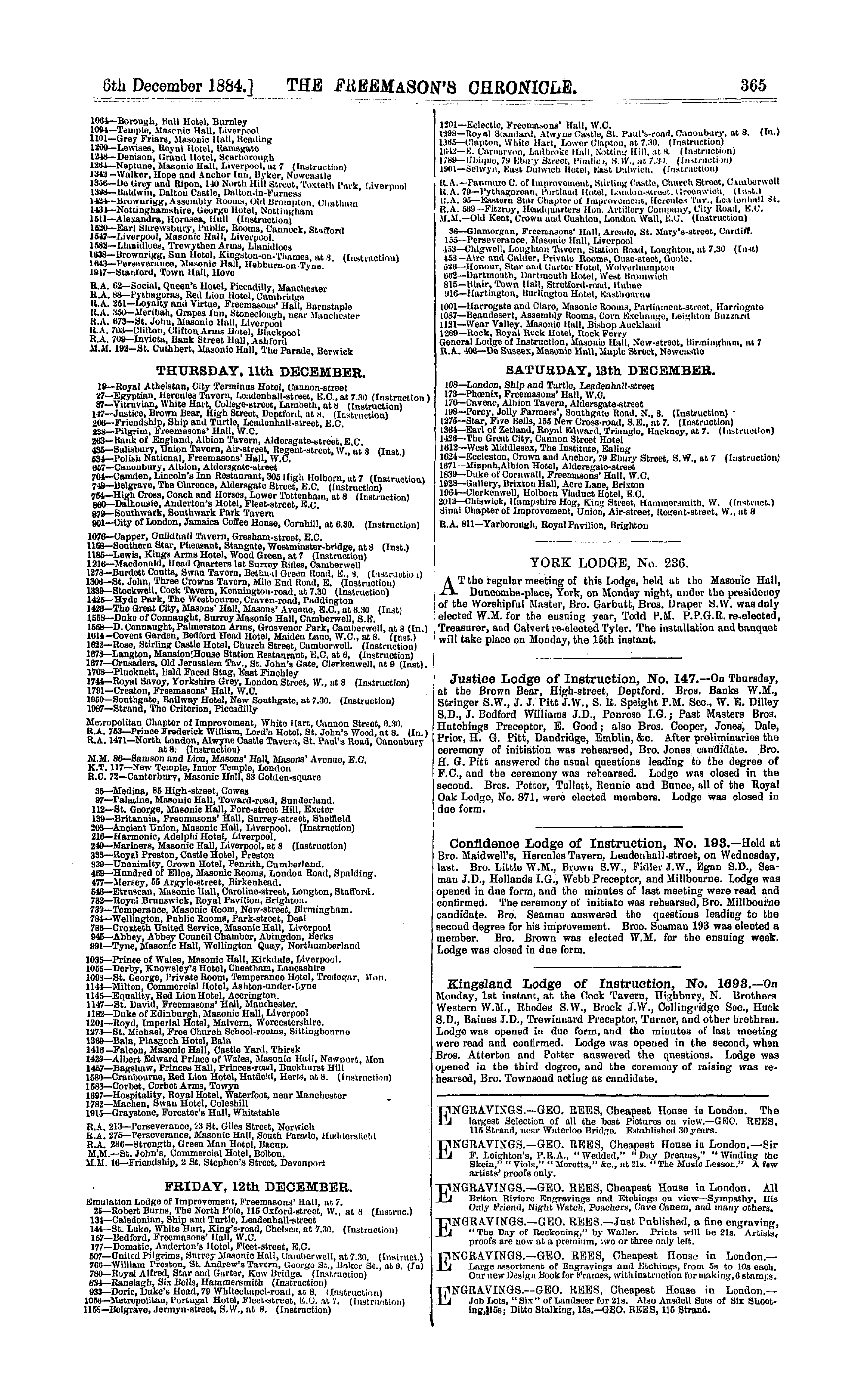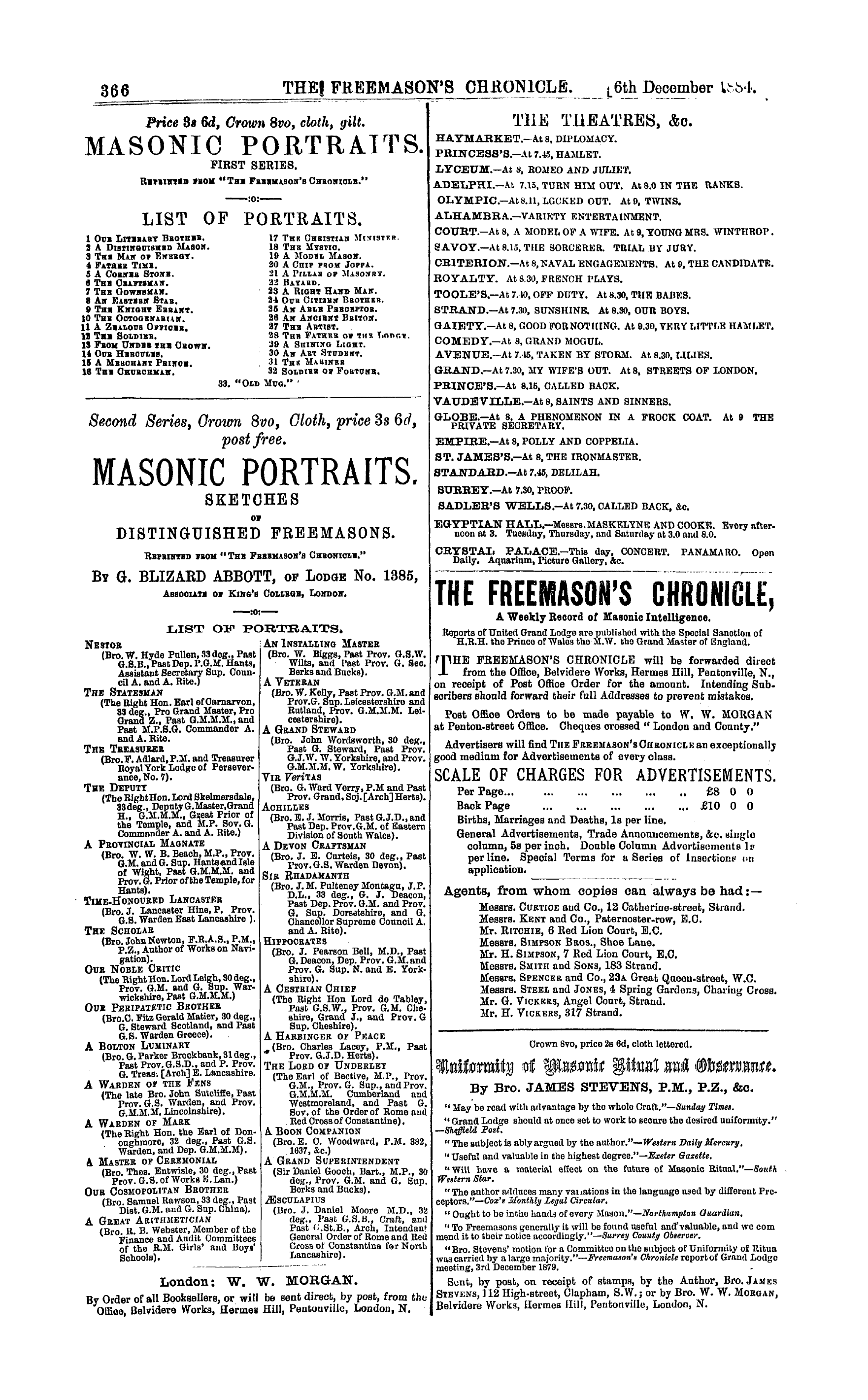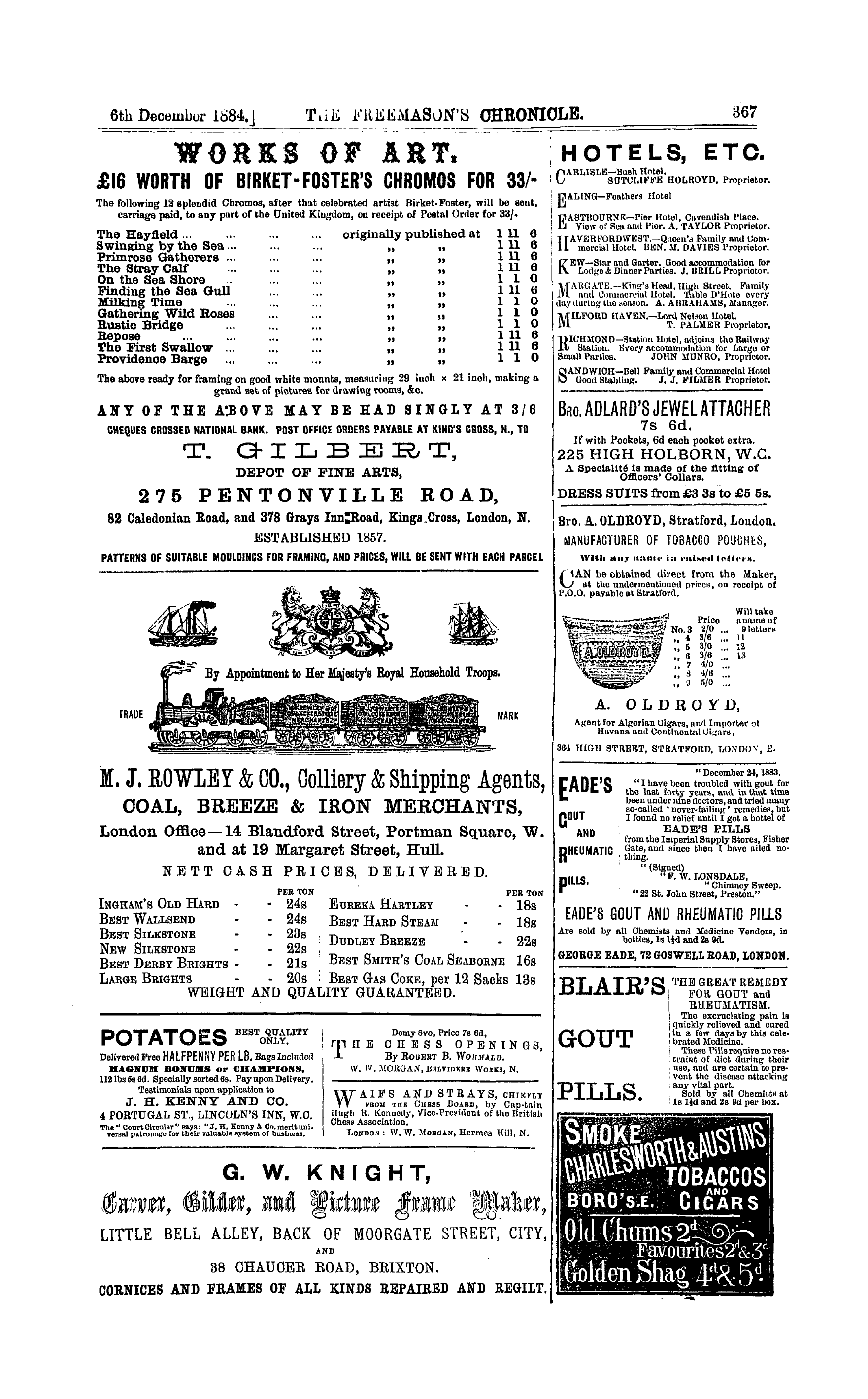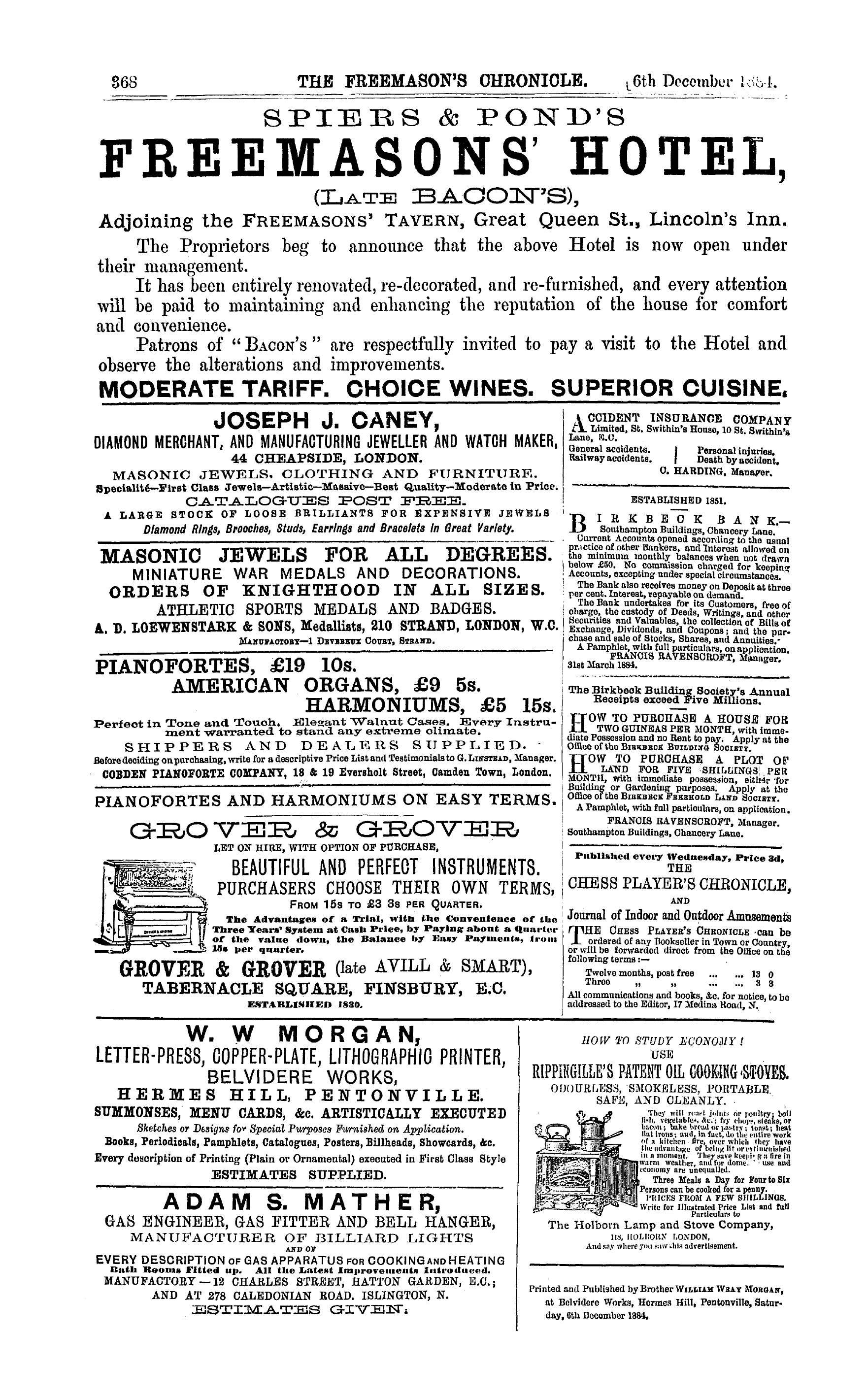-
Articles/Ads
Article BRO. DRUMMOND'S HISTORIC FALLACIES. Page 1 of 2 Article BRO. DRUMMOND'S HISTORIC FALLACIES. Page 1 of 2 →
Note: This text has been automatically extracted via Optical Character Recognition (OCR) software.
Bro. Drummond's Historic Fallacies.
BRO . DRUMMOND'S HISTORIC FALLACIES .
Bv Bi : o . JACOB NORTON . THE superiority of Bro . Drummond ' s reasoning on tho " Philadelphia Mother Question , " no ono will deny ; bat when ho attempts to prolong the existence of Masonic Grand Masters to a period prior to 1717 , his reasoning
seems to be on a par with that of tho Philadolp h ' a ' champion for the connection of Coxo with Philadelphia Masonry of 1731 . The Masonic Token copied Bro . Drummond's most recent discovery , and Bro . Rngg immediately
published it with his endorsement in tho Freemason ' s Repository ; and in order to prevent the contagion from spreading , I shall reproduce Pro . Drummnnd ' s paragraph ? and point out their fallacies . Saith Bro . Drummond :
" Bro . Charles Levi Woodbury has recently shown us a copy of a manuscript in the British Museum , which must have been written before 1717 , and which experts conclude was written before 1686 , in which is given a rule , requiring the presence of at least one operative Mason at every
Lodge . This shows conclusivel y that the change from operative to speculative had been gradual , and that when the manuscript was written the speculative element was very largo . " The ' Old Regulations' ( and of course the ' Ancient
Charges ' ) were not made in 1717 , but were then collected , and the collection approved by the Grand Lodge and published ; they were then ' Ancient Charges' and ' Old Regulations . ' Both mention more than once the Grand Master as the Supreme executive officer of the Craft . It
follows that unless these ' Ancient Charges' and ' Old Regulations' are a fraud , the office of Grand Master has existed long before these Charges and Regulations were
compiled . The admission that these existed before they were compiled is also an admission that the office of Grand Master was an acient element in the polity of the Institution .
" There is one point in this connection to which we have given considerable consideration . Originally Lodges had no permanency of existence , and in 1717 it was provided that they must have a charter . It some time ago occurred to us that all this change could not have been made at once .
It is certain that prior to 1717 some Lodges had permaency of organisation entirely inconsistent with the old theory and practice , under which a Lodge could not have existence except when in actual session ; a Lodge was a mere assembly of brethren , and had no organised character .
With the Ancient Charges , there was published the form of constituting a Lodge ' according to ancient usage of Masons . ' In this form no mention is made of a charter , but in other respects they are substantially the same as those now in use . In the forms given a few years later , the
delivering of the warrant is made a prominent feature . The evidence tends very strongly to show that before 1717 Brethren were constituted into a Lodge , with Master and Wardens , and became a body of a permanent character . " Now I saw Bro . Woodbury ' s MS . about three months
ago . Briefly , then , it is the Harleian MS . No . 1942 . In No . 6 of the Masonic Truth , 1883 , 1 quoted therefrom a new oath , and in my preface to the Roberts MS . in the above paper , No . 23 , 1884 ( 7 th April ) , I showed that the Roberts MS . was copied from the Harleian , but with the
addition of one regulation and a date . This Harleian MS . consists of two parts , viz ., old and neio . It begins ( like all the other MSS ., or more properly the pre-1717 rituals ) with a prayer , followed by all the legends from the Matthew Cooke MS . ; then comes twenty-five Regulations or Charges , and winds up with an oath , thus :
" These Articles and Charge which I have rehersed to you , you shall well and truely observe , & keepe you to your power , soe helpe your god and the contents of this book . "
Thus far this MS . is old . It has not as many archaisms as other Masonic MSS . have , but thus far it is mainly copied from an older MS . Next comes the new . The first New Regulation is as follows :
" Noe person ( of what degree soever ) bee accepted a free Mason , unless hee shall have a Lodge of five free Masons atieast , where of one to bee Master or warden of that limit , or devision wherein such a Lodge shallbee kept , and another of the trade of Freemasonry . " The above regulation was referred to by Bro . Drummond ; it shows that two operatives { not one ) had to be
Bro. Drummond's Historic Fallacies.
present in the 1 . <> . lo- \ And tho fifth of t ' -u New Uegula . tions ( or as if is numbered , " ol ") is as follows : " That no p son shallbee accepted a Free Mason or k-iow tho secrets of the said Society , uutill heo hath first taken tho oath of secrecy hereafter following , —I ., A . B . Doe in the presence of Almighty God & my Fellow , " & c .
After tho oath , there are ten articles or charges designed for an operative apprentice ; and from this MS . brother Drummond inferred his wonderful discovery , that beforo 1717 Masons wore governed by a Grand Master , < fco . Somebody believes that tho said MS . was Avritton before
1686 . Now some experts claim that thoy can fix tho precise year when a MS . was written by tho ehitography or stylo of penmanship ; but I cannot boliovo that mero penmanship can fix tho period of a MS . within a limit of fifty years at least , for I have in my possession : i letter I
wrote more than thirty years ago , and the penmanship is so like my present style of penmanship that I could not tell by the mere handwriting ( if I did not examine tho contents and judge by internal evidence ) whether my own letter or MS . was written in 1850 or in 1884 . Bro . David
Pnlsifer , tho well known Boston antiquary , who owns and htis handled more old MSS . and records than many experts h : tvo , agrees with me that tho style of writing acquired
during youth adheres to the man as long as tho fingers retain the necessary strength . Now , if I cannot fix tho year of my own handwriting , how can an oxpert tell when the Harleian MS . was written ?
But perhaps the old style of spelling may bo a criterion that it must have been written before 1686 ; for instance , we have in this MS . soe , doe , hee , bee , & c . Now if that fashion of spelling had been prohibited by Act of Parliament ou the 1 st of January 1686 , there would bo reason
for believing that , it was written before 1686 ; but such an Act of Parliament was never passed , and it is not difficult to prove that the same style of spelling was in vogue for many years after 1686 . For instance , I opened , promiscuously , Pepy ' s Diary and also Evelyn's Diary . In the
former , in letters written in 1687 , I found soe , finde , bee , roame , barr , yeares , qualifyde , doe , aske , towne , myne , tnee , behalfe , and myselfe , all which words were on two pages of the book where I opened ; and Evelyn wrote in 1688—tho subject was the king ' s trouble with the bishops—and
here arc his specimens of spelling : addresse , Iware , " signed in forme" returne , "The injoyning his ministers , " greate baile , " Gitty of Lima , " & c . If then great scholars and visitors of His Majesty ' s Drawing-room spelled that way in 1688 , why mu 9 t our Masonic MS . have been written
before 1686 ? And I have here Sloane ' s MS . 3329 , which tlie Rev . Brother Woodford admits may have been written in 1715 , which contains similar spelling . But that is not all . In the petition presented to Henry Price in 1733 , and I have no doubt that it was written in 1733 , may
also be seen soe , att , & c . ; and the petition from Portsmouth , N . H ., 1736 , to Price begins with " WEB . " Why , even the extracts given by Bro Schultz from a M—d Lodge record of 1765 contains similar spelling . Well , then , spelling is no criterion for fixing the date of our MS . to 1686 .
It is my opinion that tho said MS . was written between tho latter part of the seventeenth century and 1717—probably near 1710 . My reason for supposing it to have been written in the eighteenth century , is : first , the
newfashioned oath in it ; and second , it is the only MS . as far as I know ( except Roberts' MS . ) that mentions " Wardens " and refers to the presiding officer as " Master "; thus the thirtieth Regulation ( one of the New ) ordains :
" That for the future the sayd Society , Company , & fraternity of Free Masons shall bee regulated & governed by one master , & Assembly & Wardens , as ye said Company shall think fit to chose , at every yearely general Assembly . "
The Antiquity , the Alnwicke , the . York , and the Scarborough MSS . are respectively dated 1688 , 1701 , 1704 , and 1705 . If , therefore , the Harleian MS . was written before 1686 , the later MSS . would probably have copied its
innovations ; but , with the exception of Roberts' MS ., which contains but one archaism , they are all minus of tho new oath , & c . Our MS . seems , therefore , to have been a later production .
It is a curious fact that in no old MS ., including the old part of the Harleian MS . under consideration , is the presiding officer indicated by any other title than " Senioribus , " meaning Elder or Alderman . In Scotland , the Lodge president was variously styled Master , Warden
Note: This text has been automatically extracted via Optical Character Recognition (OCR) software.
Bro. Drummond's Historic Fallacies.
BRO . DRUMMOND'S HISTORIC FALLACIES .
Bv Bi : o . JACOB NORTON . THE superiority of Bro . Drummond ' s reasoning on tho " Philadelphia Mother Question , " no ono will deny ; bat when ho attempts to prolong the existence of Masonic Grand Masters to a period prior to 1717 , his reasoning
seems to be on a par with that of tho Philadolp h ' a ' champion for the connection of Coxo with Philadelphia Masonry of 1731 . The Masonic Token copied Bro . Drummond's most recent discovery , and Bro . Rngg immediately
published it with his endorsement in tho Freemason ' s Repository ; and in order to prevent the contagion from spreading , I shall reproduce Pro . Drummnnd ' s paragraph ? and point out their fallacies . Saith Bro . Drummond :
" Bro . Charles Levi Woodbury has recently shown us a copy of a manuscript in the British Museum , which must have been written before 1717 , and which experts conclude was written before 1686 , in which is given a rule , requiring the presence of at least one operative Mason at every
Lodge . This shows conclusivel y that the change from operative to speculative had been gradual , and that when the manuscript was written the speculative element was very largo . " The ' Old Regulations' ( and of course the ' Ancient
Charges ' ) were not made in 1717 , but were then collected , and the collection approved by the Grand Lodge and published ; they were then ' Ancient Charges' and ' Old Regulations . ' Both mention more than once the Grand Master as the Supreme executive officer of the Craft . It
follows that unless these ' Ancient Charges' and ' Old Regulations' are a fraud , the office of Grand Master has existed long before these Charges and Regulations were
compiled . The admission that these existed before they were compiled is also an admission that the office of Grand Master was an acient element in the polity of the Institution .
" There is one point in this connection to which we have given considerable consideration . Originally Lodges had no permanency of existence , and in 1717 it was provided that they must have a charter . It some time ago occurred to us that all this change could not have been made at once .
It is certain that prior to 1717 some Lodges had permaency of organisation entirely inconsistent with the old theory and practice , under which a Lodge could not have existence except when in actual session ; a Lodge was a mere assembly of brethren , and had no organised character .
With the Ancient Charges , there was published the form of constituting a Lodge ' according to ancient usage of Masons . ' In this form no mention is made of a charter , but in other respects they are substantially the same as those now in use . In the forms given a few years later , the
delivering of the warrant is made a prominent feature . The evidence tends very strongly to show that before 1717 Brethren were constituted into a Lodge , with Master and Wardens , and became a body of a permanent character . " Now I saw Bro . Woodbury ' s MS . about three months
ago . Briefly , then , it is the Harleian MS . No . 1942 . In No . 6 of the Masonic Truth , 1883 , 1 quoted therefrom a new oath , and in my preface to the Roberts MS . in the above paper , No . 23 , 1884 ( 7 th April ) , I showed that the Roberts MS . was copied from the Harleian , but with the
addition of one regulation and a date . This Harleian MS . consists of two parts , viz ., old and neio . It begins ( like all the other MSS ., or more properly the pre-1717 rituals ) with a prayer , followed by all the legends from the Matthew Cooke MS . ; then comes twenty-five Regulations or Charges , and winds up with an oath , thus :
" These Articles and Charge which I have rehersed to you , you shall well and truely observe , & keepe you to your power , soe helpe your god and the contents of this book . "
Thus far this MS . is old . It has not as many archaisms as other Masonic MSS . have , but thus far it is mainly copied from an older MS . Next comes the new . The first New Regulation is as follows :
" Noe person ( of what degree soever ) bee accepted a free Mason , unless hee shall have a Lodge of five free Masons atieast , where of one to bee Master or warden of that limit , or devision wherein such a Lodge shallbee kept , and another of the trade of Freemasonry . " The above regulation was referred to by Bro . Drummond ; it shows that two operatives { not one ) had to be
Bro. Drummond's Historic Fallacies.
present in the 1 . <> . lo- \ And tho fifth of t ' -u New Uegula . tions ( or as if is numbered , " ol ") is as follows : " That no p son shallbee accepted a Free Mason or k-iow tho secrets of the said Society , uutill heo hath first taken tho oath of secrecy hereafter following , —I ., A . B . Doe in the presence of Almighty God & my Fellow , " & c .
After tho oath , there are ten articles or charges designed for an operative apprentice ; and from this MS . brother Drummond inferred his wonderful discovery , that beforo 1717 Masons wore governed by a Grand Master , < fco . Somebody believes that tho said MS . was Avritton before
1686 . Now some experts claim that thoy can fix tho precise year when a MS . was written by tho ehitography or stylo of penmanship ; but I cannot boliovo that mero penmanship can fix tho period of a MS . within a limit of fifty years at least , for I have in my possession : i letter I
wrote more than thirty years ago , and the penmanship is so like my present style of penmanship that I could not tell by the mere handwriting ( if I did not examine tho contents and judge by internal evidence ) whether my own letter or MS . was written in 1850 or in 1884 . Bro . David
Pnlsifer , tho well known Boston antiquary , who owns and htis handled more old MSS . and records than many experts h : tvo , agrees with me that tho style of writing acquired
during youth adheres to the man as long as tho fingers retain the necessary strength . Now , if I cannot fix tho year of my own handwriting , how can an oxpert tell when the Harleian MS . was written ?
But perhaps the old style of spelling may bo a criterion that it must have been written before 1686 ; for instance , we have in this MS . soe , doe , hee , bee , & c . Now if that fashion of spelling had been prohibited by Act of Parliament ou the 1 st of January 1686 , there would bo reason
for believing that , it was written before 1686 ; but such an Act of Parliament was never passed , and it is not difficult to prove that the same style of spelling was in vogue for many years after 1686 . For instance , I opened , promiscuously , Pepy ' s Diary and also Evelyn's Diary . In the
former , in letters written in 1687 , I found soe , finde , bee , roame , barr , yeares , qualifyde , doe , aske , towne , myne , tnee , behalfe , and myselfe , all which words were on two pages of the book where I opened ; and Evelyn wrote in 1688—tho subject was the king ' s trouble with the bishops—and
here arc his specimens of spelling : addresse , Iware , " signed in forme" returne , "The injoyning his ministers , " greate baile , " Gitty of Lima , " & c . If then great scholars and visitors of His Majesty ' s Drawing-room spelled that way in 1688 , why mu 9 t our Masonic MS . have been written
before 1686 ? And I have here Sloane ' s MS . 3329 , which tlie Rev . Brother Woodford admits may have been written in 1715 , which contains similar spelling . But that is not all . In the petition presented to Henry Price in 1733 , and I have no doubt that it was written in 1733 , may
also be seen soe , att , & c . ; and the petition from Portsmouth , N . H ., 1736 , to Price begins with " WEB . " Why , even the extracts given by Bro Schultz from a M—d Lodge record of 1765 contains similar spelling . Well , then , spelling is no criterion for fixing the date of our MS . to 1686 .
It is my opinion that tho said MS . was written between tho latter part of the seventeenth century and 1717—probably near 1710 . My reason for supposing it to have been written in the eighteenth century , is : first , the
newfashioned oath in it ; and second , it is the only MS . as far as I know ( except Roberts' MS . ) that mentions " Wardens " and refers to the presiding officer as " Master "; thus the thirtieth Regulation ( one of the New ) ordains :
" That for the future the sayd Society , Company , & fraternity of Free Masons shall bee regulated & governed by one master , & Assembly & Wardens , as ye said Company shall think fit to chose , at every yearely general Assembly . "
The Antiquity , the Alnwicke , the . York , and the Scarborough MSS . are respectively dated 1688 , 1701 , 1704 , and 1705 . If , therefore , the Harleian MS . was written before 1686 , the later MSS . would probably have copied its
innovations ; but , with the exception of Roberts' MS ., which contains but one archaism , they are all minus of tho new oath , & c . Our MS . seems , therefore , to have been a later production .
It is a curious fact that in no old MS ., including the old part of the Harleian MS . under consideration , is the presiding officer indicated by any other title than " Senioribus , " meaning Elder or Alderman . In Scotland , the Lodge president was variously styled Master , Warden

